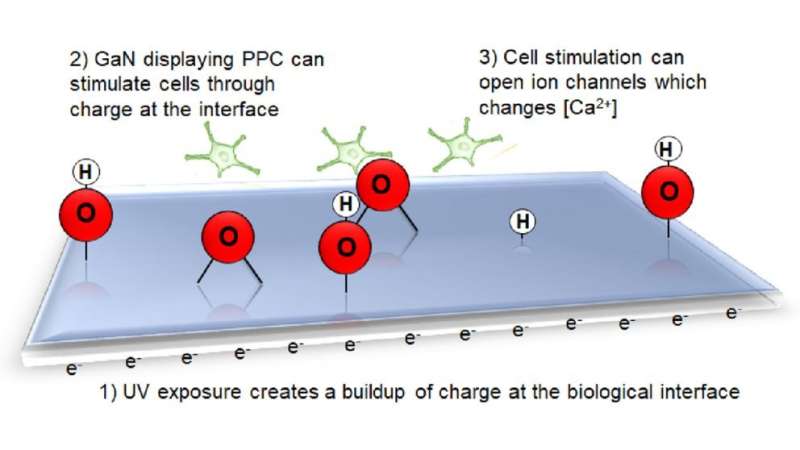Persistent photoconductivity used to stimulate neurotypic cells

Researchers have, for the first time, used a material's persistent photoconductivity to stimulate neurotype cells. The technique, which is relatively simple, should facilitate future research on using charge to influence cellular behavior.
A material that demonstrates persistent photoconductivity gains a negative charge on its surface when exposed to the right wavelength of light, and retains that charge even after the light is removed. The correct wavelength of light, and how long the material retains its charge, varies from material to material.
Researchers have known for years that electric charge can stimulate a cell, but existing technologies for conducting related experiments are often invasive or require specialized equipment. They can also be extremely time consuming.
"We wanted to take advantage of the electronic properties of the semiconductor gallium nitride, which is biocompatible, making it a true bioelectronic interface," says Patrick Snyder, a Ph.D. student at North Carolina State University and lead author of a paper on the work. "The result is a faster, noninvasive way to stimulate cells that doesn't require specialized equipment."
Specifically, the researchers exposed a gallium nitride substrate to ultraviolet (UV) light, creating a negative charge on its surface. As soon as the UV light was removed, researchers poured a solution containing PC12 neurotypic cells into the container with the substrate. The researchers then introduced a dye that allowed them to measure calcium levels in the PC12 cells.
What the researchers found was that PC12 cells were stimulated when they came into contact with the charged gallium nitride substrate, as evidenced by increased calcium ion levels within the cells, when compared to a control group that did not come into contact with a charged substrate.
This is evidence of altered behavior because ions are important in neurotypic cell activity. For example, calcium ions play key roles in neuronal signaling.
"In addition to advancing our fundamental understanding of what this material is capable of, we're optimistic that it can facilitate work by many labs interested in advancing research on cellular behavior," says Albena Ivanisevic, a professor of materials science and engineering at NC State and corresponding author of the paper.
The paper, "Non-Invasive Stimulation of Neurotypic Cells Using Persistent Photoconductivity of Gallium Nitride," is published in the open-access journal ACS Omega.
More information: Patrick J. Snyder et al. Noninvasive Stimulation of Neurotypic Cells Using Persistent Photoconductivity of Gallium Nitride, ACS Omega (2018). DOI: 10.1021/acsomega.7b01894
Journal information: ACS Omega
Provided by North Carolina State University




















